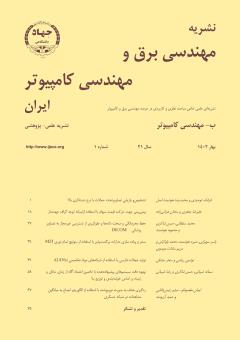سنتز و پیادهسازی مدارات برگشتپذیر با استفاده از سوئیچ تمامنوری MZI
محورهای موضوعی : مهندسی برق و کامپیوتر
یاسر سهرابی
1
,
منیره هوشمند
2
,
محمد بلوکیان
3
![]() ,
مریم موسوی
4
,
مریم موسوی
4
1 - گروه برق، دانشگاه بینالمللی امام رضا (ع) مشهد
2 - گروه برق دانشگاه بینالمللی امام رضا (ع) مشهد
3 - گروه برق، دانشگاه بینالمللی امام رضا (ع) مشهد
4 - گروه برق دانشگاه بینالمللی امام رضا (ع) مشهد
کلید واژه: محاسبات برگشتپذیر, مدارات برگشتپذیر تمامنوری, سوئیچ ماخزندر,
چکیده مقاله :
در حال حاضر، فناوری VLSI با چالشی جدی روبهرو است؛ زیرا رشد نمایی متراکمسازی در تراشههای VLSI و CMOS به حد نهایی خود رسیده است. اتلاف توان در تراشه VLSI به تولید گرما اطلاق میشود که یک مانع واقعی در برابر فناوری سنتی CMOS است. منطق غیر برگشتپذیر منجر به مشکلاتی از قبیل اتلاف انرژی، تولید گرما، ازدستدادن اطلاعات و کندشدن محاسبات میشود. برای حل این مشکلات، نیازمند یک فناوری جدید هستیم و استفاده از منطق برگشتپذیر میتواند به حل این مشکل کمک کند. مدارهای برگشتپذیر در بسیاری از برنامههای کاربردی شامل طراحیهای توان پایین، اهمیت زیادی دارند. منطق برگشتپذیر دارای بسیاری از کاربردهای دیگر در چندین فناوری مانند محاسبات کوانتومی، پردازش سیگنال دیجیتال، رمزنگاری، طراحی CMOS توان پایین، فناوری نانو، ترمودینامیک و بیوانفورماتیک است و اکثر آنها در حال حاضر تحت تحقیق هستند. یکی از زمینههای اصلی که مدارهای برگشتپذیر نقشی حیاتی در آن دارند، محاسبات نوری است. در میان رویکردهای برگشتپذیر، ثابت شده که محاسبات نوری میتوانند سرعت بسیار بالایی ایجاد کنند؛ زیرا فوتونهای موجود در نور دارای سرعت بسیار بالایی هستند. در کامپیوترهای نوری نسل آینده، مدارهای الکتریکی و سیمها توسط تعدادی فیبر نوری جایگزین خواهند شد که این سیستمها کارایی بیشتری خواهند داشت؛ زیرا بدون تداخل، ارزانتر، سبکتر و فشردهتر خواهند بود. بر اساس محاسبات نوری، چندین سوئیچ نوری برای کاربردهای آینده پیشنهاد گردیده که یکی از این سوئیچها سوئیچ ماخزندر است و در این مقاله به مطالعه رفتار آن و مدارهای برگشتپذیری که با آن ساخته شده است، پرداخته میشود. در انتها سه گیت برگشتپذیر تمامنوری جدید با نامهای NFT، SRK و MPG مؤثر در طراحی مدارهای منطقی برگشتپذیر تمامنوری مثل فیپفلاپها و دیگر مدارهای ترتیبی برگشتپذیر تمامنوری را معرفی و طراحی میکنیم. همچنین به شبیهسازی برخی مدارهای برگشتپذیر تمامنوری پیادهسازی شده با سوئیچ ماخزندر میپردازیم و چالشهای شبیهسازی و راه حلهای برطرفکردن این مشکلات را ارائه مینماییم.
VLSI technology is currently dealing with a serious challenge, as the exponential growth of density in VLSI and CMOS chips has reached its limit. Power dissipation in VLSI chip refers to heat generation, which is a real barrier against traditional CMOS technology. Irreversible logic leads to problems such as energy dissipation, heat generation, information loss and slow computations. We need a new technology for solving these problems. Using reversible logic can help solve this problem. In next generation of optical computers, electrical circuits and wires will be replaced by several optical fibers and these systems will be more efficient because they will be cheaper, lighter, and more compact without interference. Based on optical computations, several optical switches have been proposed for future applications. One of these switches is the Mach-Zehnder switch. Its behavior and the reversible circuits, which can be made with this switch is studied in this article. Finally, we introduce and design three new all-optical reversible gates named NFT, SRK and MPG, which are effective in designing all-optical reversible logical circuits such as flip-flops and other all-optical reversible sequential circuits. We also simulate one all-optical reversible circuits implemented with Mach-Zehnder switch and provide simulation challenges and solutions to overcome these challenges.


